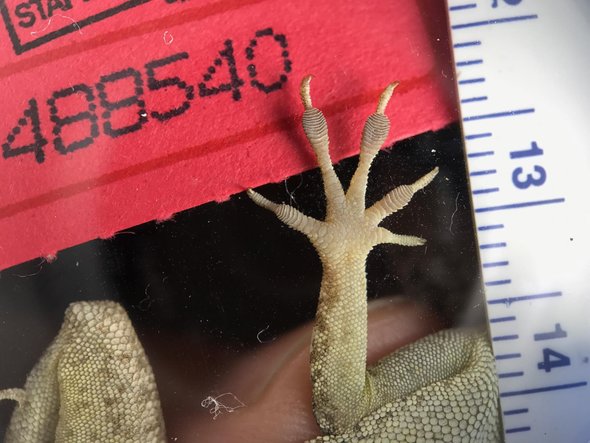(单词翻译:单击)
听力文本
This is Scientific American — 60-Second Science. I'm Jason G. Goldman.
At about 7:30 P.M. on September 7, 2017, Hurricane Irma reached the Turks and Caicos Islands. By the next morning, the neighborhood called Blue Hill was gone. And on South Caicos Island, 75 percent of rooftops were obliterated. Two weeks later, Hurricane Maria followed in Irma's destructive footsteps.
And Harvard University biologist Colin Donihue happened to be there a few days before the hurricanes blew through.
"The Turks and Caicos islands is home to a couple of different endemic species of lizard, that's lizards that are only found there. We were interested in one in particular, called Anolis scriptus, the Turks and Caicos anole."
The mission of that first expedition, before the two hurricanes, was to assay the lizard population in anticipation of a program to eradicate the islands of invasive rats—which threaten the lizards. This work included taking detailed measurements of the bodies of lizards they trapped and released.
The researchers intended to return several years later, after the rats were gone, to re-assess the lizards. But that plan changed.
"We realized after the hurricanes had come through that we had a really serendipitous opportunity to test this question of whether hurricanes can act as agents of natural selection on wild populations in their path. Now this had never really been asked before, because hurricanes are just really hard to predict...we just happened to be in the right place at the right time to have that baseline data."

Which is why he and his team returned to the archipelago...just six weeks after his first visit.
They expected that lizards with longer limbs and larger toe pads would be the ones better able to cling to trees and therefore more likely to survive the storms. And they were almost right. Longer front legs and larger toe pads indeed helped. But shorter hindlimbs were actually better. The results are in the journal Nature.
To figure out these counterintuitive findings, the researchers conducted an experiment in a hotel room. They rounded up some lizards, gave them a perch, and used a leaf blower to mimic the effects of high winds. They set up a net to catch any lizards that lost their grip.
As the artificial wind blew, the lizards moved so the perch took most of the air flow. But their hind legs would stick out—and if those rear limbs stuck out too far, they acted as sails.
"Eventually those back legs were blown off the perch, and the lizards were just holding on with their front two legs. And they could only hold on like that for so long as the wind speed increased further and further, until they were blown off the perch and into the nets."
So shorter back legs gave a survival advantage. A trait that might be passed on to the next lizard generation.
Thanks for the minute for Scientific American — 60-Second Science. I'm Jason G. Goldman.
参考译文
这里是科学美国人——60秒科学。我是杰森·古德曼。
2017年9月7日晚7点30分左右,飓风“厄玛”抵达特克斯和凯科斯群岛。到第二天早上,该群岛附近的“蓝山”社区已完全消失。在南凯科斯岛,75%的屋顶彻底被毁。两周之后,飓风“玛丽亚”紧随“厄玛”的毁灭性脚步而来。
而在这两起飓风来袭的前两天,哈佛大学的生物学家科林·多尼克恰巧就在该岛上。
“特克斯和凯科斯群岛是几种特有品种蜥蜴的家园,这些蜥蜴只有那里才有。我们对其中一种被称为安乐蜥属的的特克斯和凯科斯变色龙尤为感兴趣。”
在两场飓风之前进行的首次考察的任务是测定蜥蜴数量,以期待实施一项消灭岛上入侵老鼠的计划——这些老鼠对蜥蜴构成威胁。这项工作包括对捕获的老鼠进行详细测量,然后再将它们放生。
研究人员本打算几年后,也就是在老鼠灭绝之后,再回到岛上对蜥蜴进行重新评估。但是这个计划改变了。
“在两次飓风过后,我们意识到自己获得了测试这个问题的偶然机会:飓风是否能充当对其路径上的野生种群进行自然选择的代理人?这个问题此前从未被提出过,因为飓风相当难以预测,我们只是碰巧在正确的时间和地点获得了这些基线数据。”
这就是他和团队在首次造访6周后便回到了那个群岛的原因。
他们原本以为那些四肢较长、趾垫更大的蜥蜴能更好地附着在树上,因而更有可能在风暴中存活下来。他们的想法基本上是对的。前肢更长、趾垫更大确实有帮助。但实际上,后肢较短更有利。研究结果发表在《自然》期刊上。
为了弄清楚这些反直觉的发现,研究人员在酒店房间里进行了一项实验。他们围捕了一些蜥蜴,给它们一根栖木,然后用鼓风机模拟强风的效果。他们铺设了一张网,用来接住没抓住栖木的蜥蜴。
当人造风吹来时,蜥蜴会移动位置,因此栖木承受了大部分气流。但蜥蜴的后肢会伸出来——如果后肢会伸得过远,就会起到帆的作用。
“最后,风会把它们的后肢从栖木上吹下去,蜥蜴只能用两条前腿抓住栖木。随着风速越来越大,它们只能一直这样在栖木上坚持着,直到它们被吹下来落到网里为止。”
因此,较短的后肢提供了生存优势。这种特征可能会传给下一代蜥蜴。
谢谢大家收听科学美国人——60秒科学。我是杰森·古德曼。
译文为可可英语翻译,未经授权请勿转载!
重点讲解
重点讲解:
1. cling to 紧紧抓住;抱紧;
Another man was rescued as he clung to the riverbank.
另外一个人因为紧紧攀住河堤而获救。
2. round up 围捕;逮捕;
They are trying to round up those robbers.
他们正在努力围捕那些强盗。
3. hold on 坚持;
Despite her aching shoulders, Nancy held on.
南希紧抓不放,不顾双肩疼痛。
4. pass on to 将…传给;将…交给;
The late Earl passed on much of his fortune to his daughter.
已故伯爵将他的大部分财产传给了女儿。


